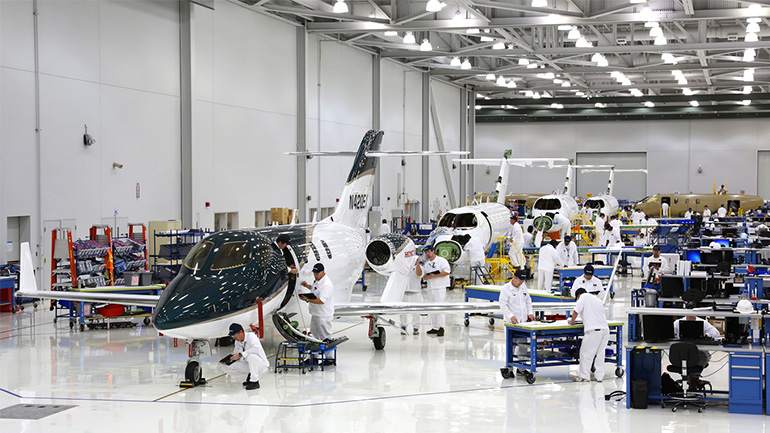Honda Aircraft Company announced several achievements and milestones in the development of the http://www.hondajet.com/HondaJet during a press conference at the European Business Aviation Convention and Exhibition (EBACE) in Geneva, Switzerland. The company revealed the first production HondaJet. The aircraft is ready for ground tests and features a new paint scheme, a deep pearl green with a gold stripe. The company also shared its progress in preparation for HondaJet entry into service.
“Honda Aircraft Company’s most important goals are achieving Federal Aviation Administration Type Certification and delivering the first customer aircraft,” said Honda Aircraft Company President and CEO Michimasa Fujino. “Our total effort is focused on reaching these much anticipated milestones in the first quarter of 2015.”
First Production HondaJet Debuts With New Color
The first production aircraft is in final assembly with the first set of production GE Honda HF120 engines recently delivered to Honda Aircraft. The engines have been installed, and Honda Aircraft will soon begin conducting ground tests on the airplane. Its first flight is anticipated this summer. The aircraft debuts a new exterior paint scheme in a deep pearl green with a gold stripe. With its debut, all five exterior color options are represented in the HondaJet fleet. The deep green finish will be offered in addition to the vibrant silver, red, yellow and blue exterior colors currently available to appeal to a variety of customer preferences.
Production Readies for Deliveries
HondaJet production continues its steady pace in advance of entry into service with nine aircraft on the final assembly line. Four aircraft have been mated to their wings and empennages, and production is on schedule to have 10 aircraft on the final assembly line in June. This steady build up supports Honda Aircraft Company’s objective to have aircraft ready for delivery immediately after type certification is achieved next year.
“The HondaJet production line is maturing with efficient and robust processes in place to build high quality aircraft,” said Fujino. “From handheld tablets that deliver worker instructions to an automatic guided cart to pick up and deliver parts, we continue to integrate the latest technology into our production process to create an efficient workflow.”
Certification and Testing
Following the FAA’s issuance of Type Inspection Authorization (TIA) for the HondaJet, the program has begun testing with FAA pilot participation. Several certification tests by FAA pilots were conducted under this final phase. Examples are:
Stall speed, stall characteristics and stall warning system: Tests were conducted under various flight conditions. During testing, the stall warning system (stick shaker attached to the yoke) and stall protection system (stick pusher that provides automatic stall recovery) were evaluated. Cockpit indications for airspeed, altitude and ambient temperature were also validated.
Wheels, tires and brake control system tests: Normal anti-skid brake control systems were evaluated in both wet and dry runway conditions. Emergency brake system testing also demonstrated aircraft braking capability during degraded system operations.
Flap actuation system and speed brake operation throughout the flight envelope: Testing demonstrated aircraft flap and speed brake operation at limit speeds and maximum load factor.
Hydraulic system control tests were conducted during normal, abnormal and degraded operations: The hydraulic system was demonstrated at the maximum operating altitude and after extended periods of high-altitude cold soaking.
In-flight fire suppression system: This testing was conducted at critical flight conditions for both speed and temperature.
FAA Full-Scale Fatigue Testing: The ground structural test program has completed more than 2,000 cycles so far in advance of entry into service. This is equivalent to more than five years of use for typical business jet operators. Testing examined the airframe’s fatigue strength under simulated in-flight operations derived from theoretical load spectra and mission profiles. The tests evaluated the effects of vertical and lateral maneuvers; vertical and lateral gust; landing; taxi; Ground-Air-Ground (GAG) and fuselage pressure cycle on the aircraft. This testing was conducted at Honda Aircraft Company’s R&D facility in Greensboro, N.C., using a sophisticated structural test system that can simultaneously operate 73 hydraulic actuators and cabin pressurization in a closed loop digital control system using force, pressure or displacement as the feedback parameters.
Major Industry Supplier to Participate in the HondaJet Program
Honda Aircraft Company also announced at EBACE that Fokker Aerostructures will supply the empennage structure for the HondaJet. Fokker was selected based on its expertise in the manufacturing of tail sections for business jets with a global supply chain network.
Headquartered in Papendrecht, the Netherlands, Fokker Technologies operates facilities in the United States, Mexico, Canada, Romania, Turkey, Singapore and China. The company provides a range of integrated aerospace systems and services to top commercial and business aviation manufacturers worldwide.
The HondaJet Ownership Experience: Flight and Maintenance Training
Honda Aircraft is putting significant effort and investment into pilot and maintenance training for customers. Working with FlightSafety International, Honda Aircraft is currently developing flight and maintenance training curriculums with maintenance training classes scheduled to begin later this year in Greensboro, N.C. The first flight simulator for flight training is complete and software integration is underway. Flight training with this simulator will include type rating and recurrent pilot training programs for both single and multi-crew operations. Training will be provided at Honda Aircraft Company’s world headquarters and will start before entry into service.
Continued Company Growth — More Than 1,000 People Working at Honda Aircraft
Honda Aircraft marked a significant milestone earlier this year with its 1,000th team member joining the company. The company’s growing workforce represents more than 43 countries and reflects the aviation industry’s top talent in engineering, manufacturing, sales and service.
“Honda Aircraft Company, along with our worldwide network of dealers and suppliers, are working together to support a seamless transition to customers,” said Fujino. “Our goal is to have everything ready before the first delivery. We are committed through our network to deliver the best ownership experience from day one.”

